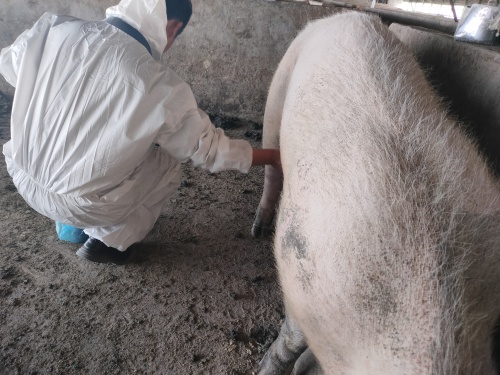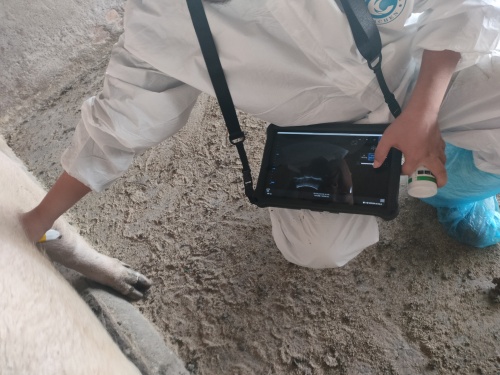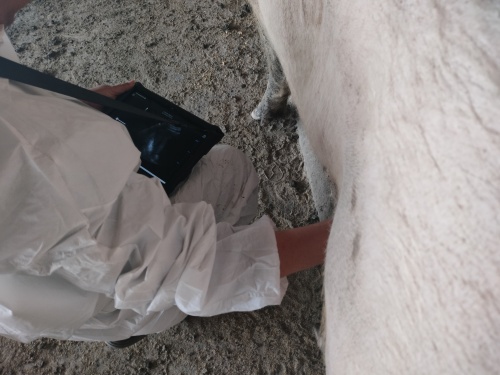Efficient livestock management has always been a balancing act between animal welfare, farm productivity, and economic returns. For decades, farmers relied heavily on visual observation, palpation, and experience to make decisions about feeding, breeding, and health interventions. Today, technological advances—particularly portable ultrasound—have revolutionized livestock care, bridging the gap between farmers and veterinarians while enabling precise, real-time decision-making on the farm.

Why Portable Ultrasound Matters in Modern Livestock Management
Portable ultrasound has reshaped how farmers monitor livestock, whether it’s for pregnancy diagnosis, assessing fat cover, or evaluating muscular development. Unlike stationary machines, portable devices allow veterinarians to perform scans directly in the field without stressing the animals. This mobility is particularly useful for large farms, remote locations, or when working with less docile species.
Par exemple, when a cow or a sow is pregnant, early and accurate detection can influence feeding strategies, prevent miscarriages, and optimize calving or farrowing outcomes. De la même façon, in meat production, monitoring muscle growth and fat deposition using ultrasound enables farmers to make informed decisions about finishing animals, improving meat quality and uniformity.
From a practical standpoint, le portability of these devices also reduces farm labor and veterinary visits. A single vet equipped with a portable ultrasound can scan dozens of animals in a day, collecting data that used to require more invasive techniques or multiple observations over weeks.
Farmer-Vet Communication: Turning Data Into Action
Having access to precise ultrasound data is only half the story. The other critical factor is effective communication between the farmer and the veterinarian. On many farms, decisions such as adjusting feed rations, altering breeding schedules, or intervening in health issues rely on timely interpretation of the results.
Farmers benefit from clear explanations of what the ultrasound findings mean for animal management. Par exemple:
-
A reduced eye muscle area in growing beef cattle might suggest undernutrition or poor feed efficiency.
-
Uneven fat deposition in sows could indicate metabolic stress or disease risk.
-
Abnormal uterine fluid in a cow could signal post-partum complications requiring immediate attention.
By sharing images, annotated measurements, and actionable recommendations, veterinarians help farmers convert data into practical steps that enhance productivity and animal welfare. Many vets now use smartphone apps or cloud platforms to upload images and track animal histories, making communication faster and more transparent.

Key Ultrasonographic Parameters in Livestock Care
To illustrate how portable ultrasound informs livestock management, the following table summarizes commonly measured parameters in cattle, porcins, and sheep:
| Species | Parameter | But | Interpretation |
|---|---|---|---|
| Cattle | Eye Muscle Area (EMA) | Muscle growth and meat yield | Higher EMA indicates better muscular development for finishing or breeding |
| Cattle | Subcutaneous Fat Thickness | Fat deposition assessment | Signals readiness for slaughter or adjustment in feed |
| Pigs | Backfat Depth | Lean-to-fat ratio | Helps determine optimal market weight and feed efficiency |
| Pigs | Loin Muscle Depth | Growth monitoring | Provides insight into carcass quality and genetic potential |
| Mouton | Rump Fat Thickness | Body condition scoring | Assists in breeding selection and nutrition planning |
| Mouton | Fetal Development | Pregnancy monitoring | Ensures proper gestation management and lamb survival |
Using these measurements, farmers and vets can make targeted interventions. For instance, increasing protein or energy in rations at critical growth stages, identifying animals needing veterinary attention, or selecting the best candidates for breeding programs.

Practical Applications on the Farm
1. Pregnancy Diagnosis and Reproductive Management
Early pregnancy detection is one of the most common and impactful uses of portable ultrasound. Detecting pregnancies within 30–40 days allows farmers to:
-
Separate pregnant animals from non-pregnant ones for feed optimization
-
Plan calving or farrowing dates
-
Monitor fetal growth and detect complications early
A well-timed scan can reduce losses due to unnoticed infertility or late-term abortions. En outre, vets can track fetal heart rate, amniotic fluid volume, and placental condition, providing valuable insight into maternal health.
2. Growth and Carcass Quality Monitoring
For meat production, ultrasound allows non-invasive assessment of muscle and fat. By tracking eye muscle area, subcutaneous fat, and intramuscular fat over time, farmers can:
-
Optimize feeding regimes to reach desired carcass specifications
-
Select animals for finishing based on growth trajectories
-
Ensure uniformity in herd production, which is critical for market contracts
Portable ultrasound enables repeated measurements without causing stress, so trends can be reliably tracked.
3. Détection précoce de la maladie
Ultrasound can reveal internal abnormalities that might be invisible externally. For instance:
-
Fluid accumulation in the uterus indicating infection
-
Organ enlargement suggestive of metabolic disease
-
Abnormal tissue patterns indicating injury or inflammation
By identifying these issues early, interventions can be more effective and less costly than treating advanced disease.
4. Breeding Selection and Genetic Improvement
Farmers interested in genetic improvement benefit from ultrasound measurements because they provide objective, quantifiable traits. Muscle depth, fat deposition, et reproductive organ health can all be assessed and used to guide selection decisions, accelerating herd improvement while reducing guesswork.

Best Practices for Effective Use
To maximize the value of portable ultrasound, several practical considerations are essential:
-
Consistent scanning protocol: Use the same landmarks and measurement sites to ensure repeatable results.
-
Training and collaboration: Farmers should understand basic interpretation, while vets provide expert guidance.
-
Record keeping: Maintain a digital database of measurements, images, and animal IDs for tracking growth trends.
-
Regular communication: Share findings promptly and agree on management actions to act swiftly on issues.
Adhering to these practices transforms ultrasound from a diagnostic tool into a strategic asset for farm management.
The Farmer-Vet Partnership: A Modern Approach
One of the most important aspects of using portable ultrasound effectively is the collaborative mindset. When farmers and vets work together, everyone benefits:
-
Farmers gain insight into their livestock beyond visual observation
-
Vets can provide targeted recommendations based on objective data
-
Animals experience less stress because interventions are timely and precise
-
Overall productivity and profitability improve
This partnership also supports better welfare outcomes, as animals are treated proactively rather than reactively.
Conclusion
Portable ultrasound has become a cornerstone of modern livestock care, linking scientific precision with practical farm management. Its benefits range from early pregnancy detection and growth monitoring to disease prevention and breeding optimization. Yet, its full potential is realized only when paired with clear, consistent communication between farmers and veterinarians.
By investing in portable ultrasound technology and cultivating a strong farmer-vet partnership, livestock operations can achieve measurable improvements in productivity, animal welfare, and economic efficiency. In today’s competitive agricultural landscape, adopting these tools and strategies is no longer optional—it’s essential.